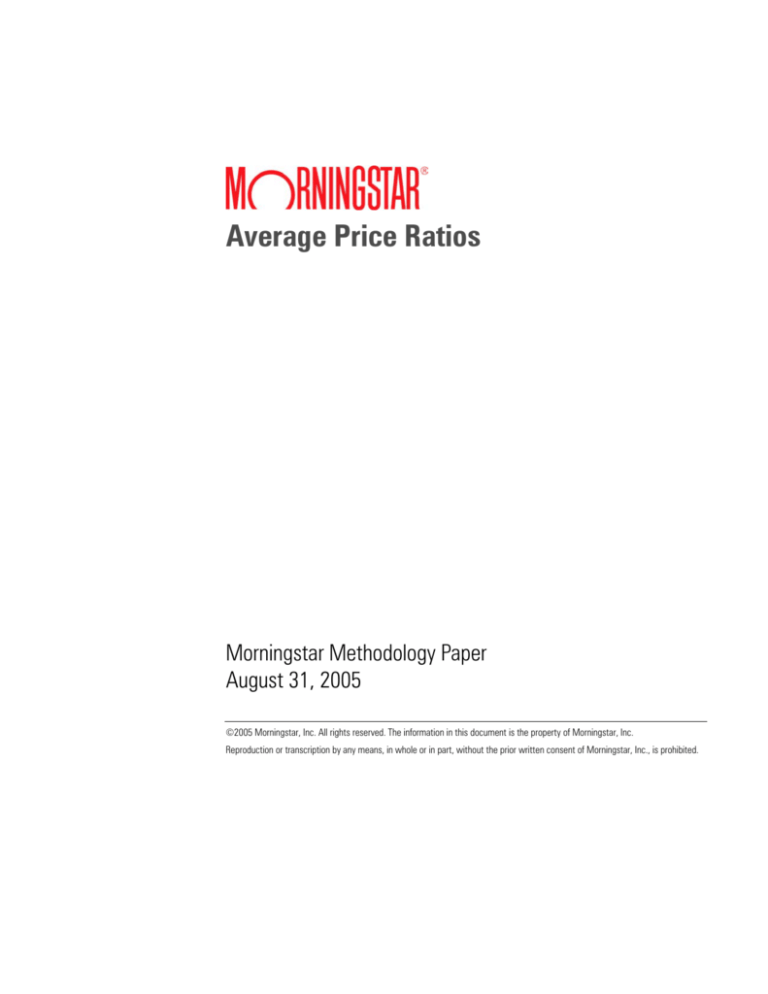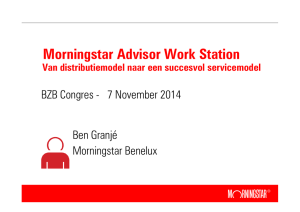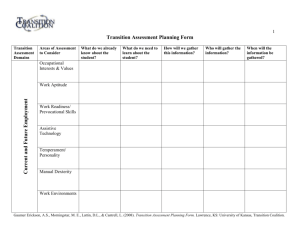
Average Price Ratios
Morningstar Methodology Paper
August 31, 2005
©2005 Morningstar, Inc. All rights reserved. The information in this document is the property of Morningstar, Inc.
Reproduction or transcription by any means, in whole or in part, without the prior written consent of Morningstar, Inc., is prohibited.
Contents
Introduction
3
What This Means For Investors
4
Harmonic Weighted Average
5
Frequently Asked Questions
7
Conclusion
8
Average Price Ratios| August 31, 2005
© 2005 Morningstar, Inc. All rights reserved. The information in this document is the property of Morningstar, Inc. Reproduction or transcription by any means,
in whole or part, without the prior written consent of Morningstar, Inc., is prohibited.
2
Introduction
Investors often evaluate how reasonable a stock’s price is by looking at a price ratio, such as
price-to-earnings (P/E), price-to-book (P/B), price-to-cash flow (P/C), or price-to-sales (P/S). Priceto-earnings measures the ratio of the most-recent stock price to 12 months of earnings-pershare, and the other ratios follow this form. Price ratios are often based on trailing-12-month
financial data, but they can also be forward-looking.
The reciprocal of a price ratio is a yield, which is obtained by taking one divided by the price
ratio. For example, E/P is an earnings yield. This measures the stock’s earnings per share as a
percentage of the stock price. A common yield measure is dividend yield, the ratio of the
dividend per share to the stock price (D/P).
Morningstar’s price ratio calculations for a stock are fairly straightforward, using the price from
the most-recent month-end, fundamental data from financial statements, and/or analysts’
earnings estimates. Morningstar also calculates average price ratios for indexes and investment
portfolios, such as mutual funds, variable annuity underlying funds, exchange-traded funds,
separate accounts, and closed-end funds. This document explains the methodology for
calculating these average price ratios.
Morningstar displays both price ratios and yields over trailing and forward time periods in our
different products. Check the product help files or product support if it is not clear which version
is displayed.
Average Price Ratios| August 31, 2005
© 2005 Morningstar, Inc. All rights reserved. The information in this document is the property of Morningstar, Inc. Reproduction or transcription by any means,
in whole or part, without the prior written consent of Morningstar, Inc., is prohibited.
3
What This Means For Investors
Price ratios give investors an indication of what they are paying for a certain level of earnings,
book value, etc. in a single stock or in a portfolio. Investors can compare an investment’s
price ratio over time, against an index, or against a peer group to evaluate if it is selling for a
fair price.
Calculating a meaningful average price ratio for a group of stocks is not as straightforward as
taking a simple average. Prior to November 30, 2005, Morningstar calculated trailing price
ratios for portfolios using an arithmetic weighted average (weighted by the market value of
each holding). While this method is commonly used in the industry, its main disadvantage is
that outliers can easily distort the results. For example, if a fund has equal (25%) positions in
four stocks with P/E ratios of 60, 25, 21, and 16, the arithmetic weighted average is 31, which
is higher than 75% of the assets in the portfolio. The result is skewed upward by one stock.
Morningstar now exclusively uses a harmonic weighted average method for calculating the
average price ratio for an investment portfolio. This method measures the valuation of the
portfolio as a whole, for example, the total “price” of the portfolio to the total earnings
purchased. For P/E, it is the ratio of the portfolio’s total market value in equities to its share of
the underlying stocks’ earnings. (For example, if a portfolio owns 500 shares of a stock
reporting earnings per share of $2.00, the portfolio’s share of those earnings is $1,000.) The
harmonic average answers the question, “What is the value and the earnings of all the stocks
bought by the portfolio manager?” This method evaluates the entire portfolio like a single stock
and it minimizes the impact of outliers.
A description of this method follows.
Average Price Ratios| August 31, 2005
© 2005 Morningstar, Inc. All rights reserved. The information in this document is the property of Morningstar, Inc. Reproduction or transcription by any means,
in whole or part, without the prior written consent of Morningstar, Inc., is prohibited.
4
Harmonic Weighted Average
Morningstar calculates the average price ratio for an investment portfolio or index as a
harmonic weighted average. For price-to-earnings, the harmonic average is the ratio of the
portfolio’s total market value to the total earnings of the portfolio:
n
P
=
E
[1]
∑ (P × S )
i =1
i
i
n
∑ ( EPS
i =1
i
× Si )
where:
P/E
=
Price-to-earnings ratio of the portfolio
Pi
=
Month-end closing price of stock i
Si
=
Number of shares of stock i held in the portfolio
EPSi
=
Earnings-per-share for stock i (over 12 months, trailing or forward)
n
=
Number of stocks in the portfolio that have price available and EPS > 0.
To calculate the portfolio P/B, P/C, and P/S, replace EPS in equation 1 with BPS (book value
per share), CPS (cash flow per share) and SPS (sales per share), respectively. To calculate
dividend yield, substitute DPS (dividend per share) for EPS in equation 1 and take the reciprocal
of the result.
× If a stock has a negative value for the financial variable (EPS, CPS), the stock will be excluded
from the calculation.
× The price ratio will only be calculated if at least 50% of the investment portfolio has price
and positive financial data.
× ADRs are included if coverage is available.
× All fundamental values (price, earnings-per-share, etc.) are converted into a single common
currency before performing this calculation. This allows us to aggregate stocks that report
financial statements in different currencies.
Average Price Ratios| August 31, 2005
© 2005 Morningstar, Inc. All rights reserved. The information in this document is the property of Morningstar, Inc. Reproduction or transcription by any means,
in whole or part, without the prior written consent of Morningstar, Inc., is prohibited.
5
There are two different but equivalent ways to calculate the harmonic average price ratio.
The previous formula (equation 1) is equivalent to the reciprocal of the weighted average yield.
Because this approach is based on yields, it naturally minimizes the influence of very large
price ratios.
n
[2]
P
=
E
∑ (P × S )
i =1
i
i
n
∑ ( EPS
i =1
i
1
EPS i
(
× wi )
∑
Pi
i =1
=
n
× Si )
where:
wi
=
weight of stock i in the portfolio (market value of stock i divided by the total market value of all portfolio
equities with available earnings yields)
The right-hand side of the above harmonic equation looks similar to the arithmetic method;
however, the two methods are distinct and are not mathematically equivalent.
Harmonic
[3]
≠
1
≠
n
EPS i
(
× wi )
∑
Pi
i =1
Arithmetic
n
Pi
∑ ( EPS
i =1
× wi )
i
Average Price Ratios| August 31, 2005
© 2005 Morningstar, Inc. All rights reserved. The information in this document is the property of Morningstar, Inc. Reproduction or transcription by any means,
in whole or part, without the prior written consent of Morningstar, Inc., is prohibited.
6
Frequently Asked Questions
Morningstar’s price ratios don’t match the price ratios from my fund company. Why?
There is no single industry standard for calculating average price ratios. Some institutions use
the arithmetic weighted average, while others use the harmonic average, a trimmed mean, a
median by market value, or a median by count. This means that Morningstar’s data may not
always match the data provided by another financial institution. Mismatches may also occur if
the other institution is using stock or portfolio data from a different date than Morningstar or if
one is trailing and the other is forward-looking.
When did Morningstar adopt this approach?
Prior to November 30, 2005, Morningstar calculated trailing price ratios for portfolios with the
arithmetic method1 and prospective price ratios with the harmonic method. After that date,
Morningstar began using the harmonic method exclusively for this calculation. Price ratios for
historical portfolios were recalculated with the harmonic method, using historical stock data
from the portfolio date.
Do these price ratios affect my fund’s Morningstar Style Box?
No, fund-level price ratios do not directly affect Style Box assignments for funds. Morningstar
uses stock-level price ratios and growth rates to determine a stock’s style score, which
determines its position along the horizontal axis of the Style Box. A fund’s Style Box is based on
an asset-weighted average of the style and size scores for the underlying stocks.2 Therefore,
the fund’s Style Box assignment will not be directly affected by the fund price ratios; those are
not used in the fund Style Box calculation.
1
Stock Price Ratios
Stock Growth Rates
Fund Price Ratios
Stock Style Score
Fund Style Score & Style Box
With the arithmetic method, Morningstar applied the following caps to stock data to minimize the impact of outliers: P/E at 60, P/B
at 30, P/C at 40 and P/S at 30. These upper bounds are not needed with the harmonic method.
2
See the document entitled The Morningstar Style Box Methodology for more details.
Average Price Ratios| August 31, 2005
© 2005 Morningstar, Inc. All rights reserved. The information in this document is the property of Morningstar, Inc. Reproduction or transcription by any means,
in whole or part, without the prior written consent of Morningstar, Inc., is prohibited.
7
Conclusion
Investors use price ratios (price-to-earnings (P/E), price-to-book (P/B), price-to-cash flow (P/C),
price-to-sales (P/S), and dividend yield (D/P)) to determine if a stock is under- or over-valued and
to evaluate a portfolio manager’s stock choices. Morningstar calculates average price ratios for
indexes and investment portfolios using the harmonic weighted average. This method
compares the total market value of the portfolio to the portfolio’s share of the underlying stocks’
earnings (or book value, cash flow, sales or dividends). Morningstar prefers the harmonic
method to an arithmetic weighted average, because outliers can easily skew the results of the
arithmetic method. Another advantage of the harmonic method is that it evaluates a portfolio
like a single stock and measures its overall valuation.
Average Price Ratios| August 31, 2005
© 2005 Morningstar, Inc. All rights reserved. The information in this document is the property of Morningstar, Inc. Reproduction or transcription by any means,
in whole or part, without the prior written consent of Morningstar, Inc., is prohibited.
8









